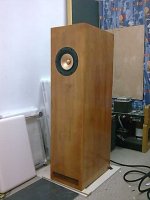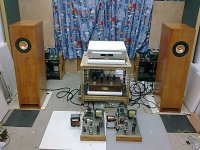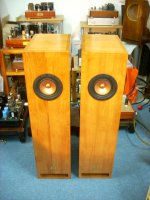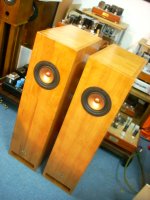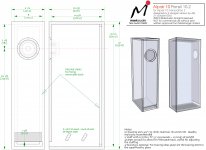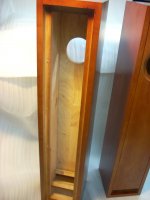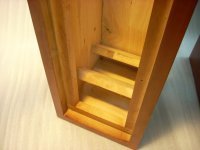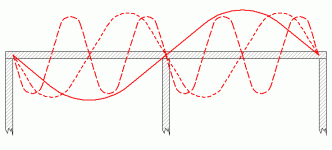My cabinets are not from SAC. May stick the ebony veneer from a same source. I like the textures of this black wood much more than this.
Wow! Simply stunning! I wish I could do work like that ...
Eagerly awaiting your (further) listening impressions!This is Pensil 10.2 (oakwood cabinets) at Kenneth's place.
I'm uncertain which enclosures to use for my 10.2's, probably Dave's "Fonken-prime"-- (maybe that should be "Monken - Prime!)
The Pencils are also attractive, maybe both!
Best, Don
Mark,
I am breaking in my speakers and have a stupid question. how do i know how hard they are being pushed without some sort of measurement device? I have them playing on very low levels to the point where they are hard to hear with any other noise present. Is this sufficient or can i push them a little more. I can hardly tell the cone is even moving. In your break-in thread you speak of excursion when defining how hard they are being pushed. Is there a way to measure this with any accuracy? THanks!
Hi Buzz,
Good question and my apologies. As engineers, we get used to observing moving objects all day long. Its reasonably easy for us to look at a driver's power-train while under load to broadly assess the amount of excursion. We also have laser based excursion-load measuring equipment.
A good way for the DIY'er to judge is........
First 100 hours, use light background type music (vocals, easy listening etc) at Very modest levels where the cone hardly flickers and you can easily hold a conversation without having to raise you your voice. Basically, the drivers should be playing in the background rather like hotel lobby music, gentle and soothing, not intrusive.
After this first 100 hour period, gradually increase volumes. Start introducing bass music. Between 100 to 200 hours, your just need to see the cone flicker up and down with little movements. A good way to gauge this is carefully place a ruler next to front suspension. Visualise the mm scale on the ruler and pan across to the cone's outer edge. You're looking for around a maximum 1 mm of excursion on a drum beat. After 200 hours, a bit more volume so the cone's now moving more regularly, up to normal listening levels and a touch more volume when you're in the mood for a bit of musical drama.
Its worth noting that in a well matched driver/cab combination, the driver's power-train won't need to move much. About 2 to 3-mm should generate a very pleasing bass from Markaudio drivers. Take a look at Olav's experience (post No.6):
http://www.diyaudio.com/forums/markaudio/182319-alp10-2-17literbr.html
Cheers
Mark.
Last edited:
movement of cone!!
Hi everyone!
What I do to see and keep track of how much the cone is moving is: I hold my finger AT the Black RubberRing that runs around the rim of the diameter of the cone. That way you can feel the rubber move ca. 1 mm - maybe a LITTLE more(1,5mm mostly). Depends on how much bass on the tracks you are playing.
Today I have had about 200 hours on the drivers - and still I am careful!
And the speakers fill the room nearly - even with this low volume. Sounds like much bigger speakers - really!
Best to all
Olav
Hi everyone!
What I do to see and keep track of how much the cone is moving is: I hold my finger AT the Black RubberRing that runs around the rim of the diameter of the cone. That way you can feel the rubber move ca. 1 mm - maybe a LITTLE more(1,5mm mostly). Depends on how much bass on the tracks you are playing.
Today I have had about 200 hours on the drivers - and still I am careful!
And the speakers fill the room nearly - even with this low volume. Sounds like much bigger speakers - really!
Best to all
Olav
A new pair Pensil 10.2 finished yesterday. It took me 5-6 hours for assembly and installation. Great style and nice looking for the finished Pensil 10.2. I love them. Thanks for the efforts made by Mark and Scott on Alpair 10.2 full range driver and Pensil 10.2 cabinet.
Cheers!
Tony.
Cheers!
Tony.
Attachments
Oh I see. Thanks Scott. I have a possibly dumb question. In many box plans, including the super pensil, it seems as if the verticle bracing behind the speaker isn't centered. Is there a reason why it's offset to one side rahter than smack dab in the middle of the driver? I'm guessing for motor ventillation (if it has a center vent) but I could be wrong.
Thanks,
Steven
Thanks,
Steven
Thanks, Steven,
The bottom braces are the function which stops damping material inside Pensil cabinet dropping down to bottom and block vent. All of my Pensil series cabinets are made this bottom braces. See my Pensil 7 cabients.
The bottom braces are the function which stops damping material inside Pensil cabinet dropping down to bottom and block vent. All of my Pensil series cabinets are made this bottom braces. See my Pensil 7 cabients.
Beautiful work. Are those bottom braces a new addtion to the plans? Perhaps a more practical alternative to cabinet bracing than the super pensil type of bracing? Or do they possibly shape the sound of the cabinet? Just curious.
Attachments
They're not as effective
They will have little to no effect on cabinet bracing. They will thou help hold the damping material up.
dave
edit: i see Tony beat me to that last bit
Oh I see. Thanks Scott. I have a possibly dumb question. In many box plans, including the super pensil, it seems as if the verticle bracing behind the speaker isn't centered. Is there a reason why it's offset to one side rahter than smack dab in the middle of the driver? I'm guessing for motor ventillation (if it has a center vent) but I could be wrong.
Thanks,
Steven
actually to distribute resonances of unbraced panels to (ranges of) multiple frequencies at lower amplitudes
In many box plans, including the super pensil, it seems as if the verticle bracing behind the speaker isn't centered. Is there a reason why it's offset to one side rahter than smack dab in the middle of the driver?
A brace dead centre is not very effective at killing the 1st panel mode. As you can see in the sketch, a centrally placed brace clamps the panel at the null of many modes & thius can encourage them.
One of the rules of bracing is: A brace should divide a panel into unequal sub-panels.
In addition to the vertical driver brace, cross-braces are also recommended.

dave
Attachments
Looks like the holes in the braces are either painted black/a shadow/ lined with something??A brace dead centre is not very effective at killing the 1st panel mode. As you can see in the sketch, a centrally placed brace clamps the panel at the null of many modes & thius can encourage them.
One of the rules of bracing is: A brace should divide a panel into unequal sub-panels.
In addition to the vertical driver brace, cross-braces are also recommended.

dave
Don
Last edited:
C'mon guys, cut loose-- get a new one!!!!Burned from high friction... you've no doubt experienced the smoking hole saw.
dave
-"honey, what's that burning smell--?"

Don
C'mon guys, cut loose-- get a new one!!!!
-"honey, what's that burning smell--?"
Don
I get rushed and tend to run the drill a bit too fast, so even a sharp hole saw tends to scorch the glue in the BB - generally not a problem with PB or MDF
- Status
- This old topic is closed. If you want to reopen this topic, contact a moderator using the "Report Post" button.
- Home
- More Vendors...
- Planet 10 hifi
- Pensil 10.2 or 12 wrt bass extention?
